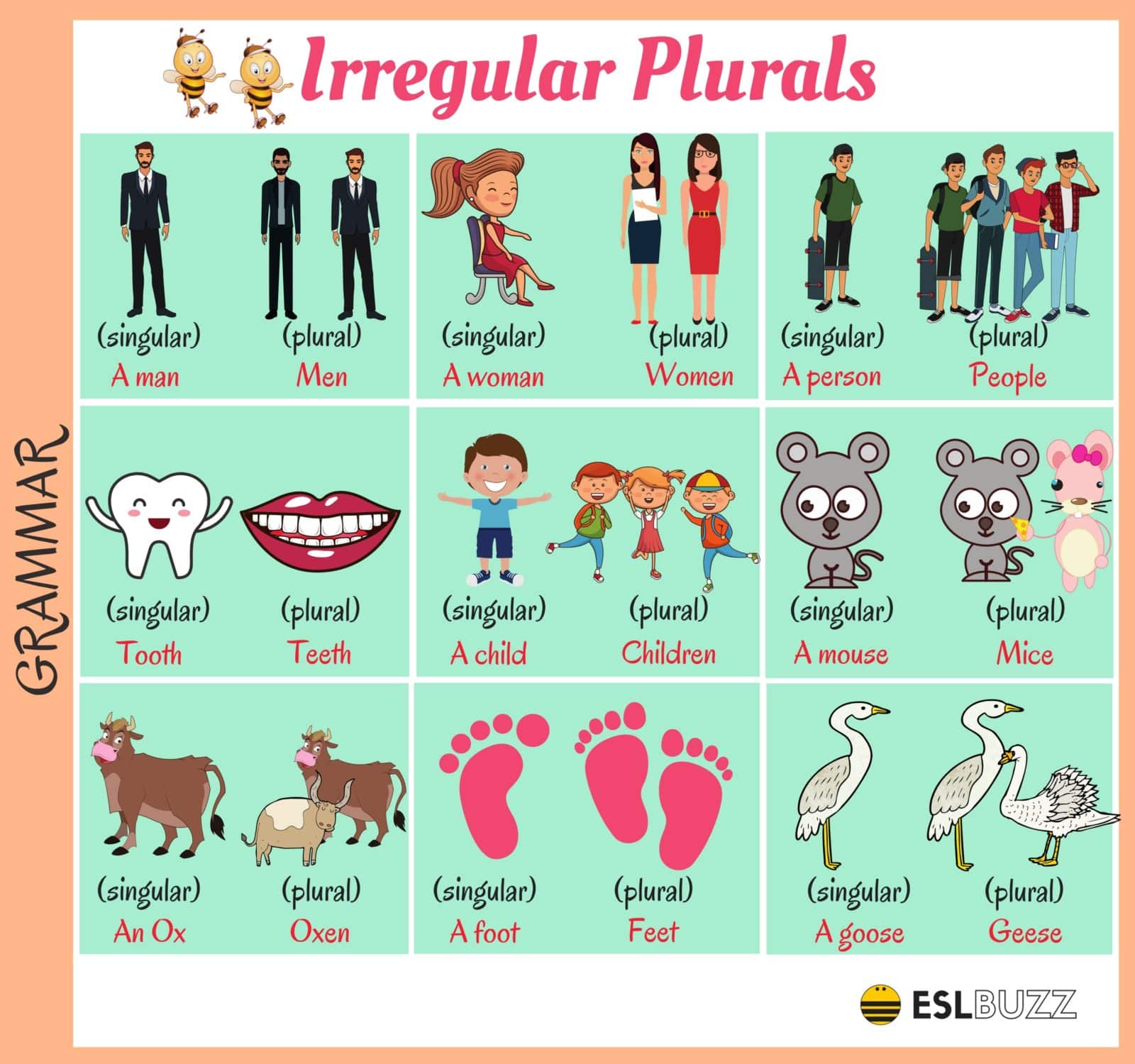Regular
/irregular-plural-nouns-in-english-1692634_FINAL-5c7829f0c9e77c00011c831a.png)
A plural noun indicates that there is more than one of that noun (while a singular noun indicates that there is just one of the noun). Most plural forms are created by simply adding an -s or –es to the end of the singular word.
Example, there’s one dog (singular), but three dogs (plural).
However, English has both regular and irregular plural nouns. Regular plurals follow this rule (and other similar rules), but irregular plurals are, well, not regular and don’t follow a “standard” rule.
As was mentioned earlier, we add the plural suffix –s to most words:
- cat → cats
- bear → bears
- zebra → zebras
However, after sounds s, z, sh, ch, and j, we add the plural suffix –es:
- class → classes
- sash → sashes
- fox → foxes
After the letter o.
We also add the plural suffix –es to most words that end in o:
- potato → potatoes
- hero → heroes
- mosquito → mosquitoes
However, when the words have a foreign origin Greek,we just add the plural suffix –s
- taco → tacos
- avocado → avocados
- maestro → maestros
After –y and –f, –fe
When a word ends in y and there is a consonant before y, we change the y to i and add –es.
- sky → skies
- candy → candies
- lady → ladies
However, if the y follows another vowel, you simply add an –s.
- alloy → alloys
- donkey → donkeys
- day → days
When a word ends in –f or –fe, we change the f to v and add –es.
- leaf → leaves
- life → lives
- calf → calves
However, if there are two terminal fs or if you still pronounce the f in the plural, then you simply add an –s:
- cliff → cliffs
- chief → chiefs
- reef → reefs
/irregular-plural-nouns-in-english-1692634_FINAL-5c7829f0c9e77c00011c831a.png)
Irregular
Unlike regular plurals, don’t necessarily follow any particular pattern—instead, they follow a lot of different patterns. Because of this, irregular plurals require a lot of memorization; you need to remember which nouns belong to which type of pluralization. Mastering irregulars uses a different region of your brain than regular pluralization: it’s an entirely different skill set than regular pluralization. So don’t get too frustrated if you can’t remember the correct plural. If you’re ever in doubt, the dictionary is there for you.
No Change (Base Plurals)
The first kind of irregular plural we’ll talk about is the no-change or base plural. In these words, the singular noun has the exact same form as the plural. Most no-change plurals are types of animals:
- sheep
- fish
- deer
- moose
Mid-Word Vowel Change
In a few words, the mid-word vowels are changed to form the plural. This video lists all seven of these words and their plurals.
Plural –en
And last we have plural –en. In these words –en is used as the plural ending instead of –s or -es.
- child → children
- ox → oxen
- brother → brethren
- sister → sistren
Borrowed Words –i, –en, –a, –es, –ae
The last category of irregular plurals is borrowed words. These words are native to other languages (e.g., Latin, Greek) and have retained the pluralization rules from their original tongue.
Singular –us; Plural –i
- cactus → cacti
- fungus → fungi
- syllabus → syllabi
In informal speech, cactuses and funguses are acceptable. Octopuses is preferred to octopi, but octopi is an accepted word.
Singular -a; Plural –ae
- formula → formulae (sometimes formulas)
- vertebra → vertebrae
- larva → larvae
Singular –ix, –ex; Plural –ices, –es
- appendix → appendices (sometimes appendixes)
- index → indices
Singular –on, –um; Plural –a
- criterion → criteria
- bacterium → bacteria
- medium → media
Singular –is; Plural –es
- analysis → analyses
- crisis → crises
- thesis → theses

Comentarios
Publicar un comentario